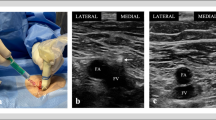Abstract
Purpose
Ultrasound (US)-guided access for venous catheter placement has previously been shown to improve success rates and decrease access-related complications. The purpose of this study was to determine the feasibility of US-guided versus traditional vascular access approaches during implantation of cardiac implantable electronic devices (CIEDs).
Methods
We evaluated outcomes for 816 consecutive patients undergoing new CIED implantation between May 2013 and April 2016 at a single institution with respect to use of US guidance for vascular access (137 with US guidance versus 679 with traditional access techniques). The primary outcome was a composite of procedural complications including deep vein thrombosis, pneumothorax, or hematoma.
Results
There was no cross-over between US guidance and traditional access. The overall complication rate was 3.6% (2.2% in US, 3.8% in non-US). The use of US was associated with a decrease in fluoroscopy time (r = −0.17, p < 0.01) but not the primary outcome (r = 0.03, p = 0.34). In models adjusted for age and number of leads, use of US was non-significantly associated with a change in fluoroscopy time (beta = −0.20, p = 0.7). In logistic models adjusted for age and number of leads, use of US was associated with a trend toward reduced major complications (OR = 0.57, 95% CI 0.17–1.91, p = 0.36).
Conclusions
US-guided vascular access for CIED implantation is safe and effective compared to traditional approaches with a non-significant reduction in both fluoroscopy time and procedural complications.

Similar content being viewed by others
References
Lau EW. Upper body venous access for transvenous lead placement--review of existent techniques. Pacing Clin Electrophysiol. 2007;30(7):901–9. doi:10.1111/j.1540-8159.2007.00779.x.
Migliore F, Siciliano M, De Lazzari M, Ferretto S, Valle CD, Zorzi A, et al. Axillary vein puncture using fluoroscopic landmarks: a safe and effective approach for implantable cardioverter defibrillator leads. J Interv Card Electrophysiol. 2015;43(3):263–7. doi:10.1007/s10840-015-0011-7.
Antonelli D, Feldman A, Freedberg NA, Turgeman Y. Axillary vein puncture without contrast venography for pacemaker and defibrillator leads implantation. Pacing Clin Electrophysiol. 2013;36(9):1107–10. doi:10.1111/pace.12181.
Hsu JC, Friday J, Lee BK, Azadani PN, Lee RJ, Badhwar N, et al. Predictors of axillary vein location for vascular access during pacemaker and defibrillator lead implantation. Pacing Clin Electrophysiol. 2011;34(12):1585–92. doi:10.1111/j.1540-8159.2011.03191.x.
Brass P, Hellmich M, Kolodziej L, Schick G, Smith AF. Ultrasound guidance versus anatomical landmarks for internal jugular vein catheterization. Cochrane Database Syst Rev. 2015;1:CD006962. doi:10.1002/14651858.CD006962.pub2.
Brass P, Hellmich M, Kolodziej L, Schick G, Smith AF. Ultrasound guidance versus anatomical landmarks for subclavian or femoral vein catheterization. Cochrane Database Syst Rev. 2015;1:CD011447. doi:10.1002/14651858.CD011447.
Fragou M, Gravvanis A, Dimitriou V, Papalois A, Kouraklis G, Karabinis A, et al. Real-time ultrasound-guided subclavian vein cannulation versus the landmark method in critical care patients: a prospective randomized study. Crit Care Med. 2011;39(7):1607–12. doi:10.1097/CCM.0b013e318218a1ae.
Wiles BM, Child N, Roberts PR. How to achieve ultrasound-guided femoral venous access: the new standard of care in the electrophysiology laboratory. J Interv Card Electrophysiol 2017. doi:10.1007/s10840-017-0227-9.
Esmaiel A, Hassan J, Blenkhorn F, Mardigyan V. The use of ultrasound to improve axillary vein access and minimize complications during pacemaker implantation. Pacing Clin Electrophysiol. 2016;39(5):478–82. doi:10.1111/pace.12833.
Jones DG, Stiles MK, Stewart JT, Armstrong GP. Ultrasound-guided venous access for permanent pacemaker leads. Pacing Clin Electrophysiol. 2006;29(8):852–7. doi:10.1111/j.1540-8159.2006.00451.x.
Seto AH, Jolly A, Salcedo J. Ultrasound-guided venous access for pacemakers and defibrillators. J Cardiovasc Electrophysiol. 2013;24(3):370–4. doi:10.1111/jce.12005.
Calkins H, Ramza BM, Brinker J, Atiga W, Donahue K, Nsah E, et al. Prospective randomized comparison of the safety and effectiveness of placement of endocardial pacemaker and defibrillator leads using the Extrathoracic subclavian vein guided by contrast venography versus the cephalic approach. Pacing Clin Electrophysiol. 2001;24(4):456–64. doi:10.1046/j.1460-9592.2001.00456.x.
Duan X, Ling F, Shen Y, Yang J, Xu HY. Venous spasm during contrast-guided axillary vein puncture for pacemaker or defibrillator lead implantation. Europace. 2012;14(7):1008–11. doi:10.1093/europace/eus066.
Nash A, Bureell CJ, Ring NJ, Marshall AJ. Evaluation of an ultrasonically guided Venepuncture technique for the placement of permanent pacing electrodes. Pacing Clin Electrophysiol. 1998;21(2):452–5. doi:10.1111/j.1540-8159.1998.tb00071.x.
Ben-Dor I, Maluenda G, Mahmoudi M, Torguson R, Xue Z, Bernardo N, et al. A novel, minimally invasive access technique versus standard 18-gauge needle set for femoral access. Catheter Cardiovasc Interv. 2012;79(7):1180–5. doi:10.1002/ccd.23330.
Baker NC, Ansel GM, Rao SV, Jolly SS, Pichard AD, Steinberg D, et al. The choice of arterial access for percutaneous coronary intervention and its impact on outcome: an expert opinion perspective. Am Heart J. 2015;170(1):13–22. doi:10.1016/j.ahj.2015.04.023.
Kirkfeldt RE, Johansen JB, Nohr EA, Jorgensen OD, Nielsen JC. Complications after cardiac implantable electronic device implantations: an analysis of a complete, nationwide cohort in Denmark. Eur Heart J. 2014;35(18):1186–94. doi:10.1093/eurheartj/eht511.
Poole JE, Gleva MJ, Mela T, Chung MK, Uslan DZ, Borge R, et al. Complication rates associated with pacemaker or implantable cardioverter-defibrillator generator replacements and upgrade procedures: results from the REPLACE registry. Circulation. 2010;122(16):1553–61. doi:10.1161/CIRCULATIONAHA.110.976076.
van Rees JB, de Bie MK, Thijssen J, Borleffs CJ, Schalij MJ, van Erven L. Implantation-related complications of implantable cardioverter-defibrillators and cardiac resynchronization therapy devices: a systematic review of randomized clinical trials. J Am Coll Cardiol. 2011;58(10):995–1000. doi:10.1016/j.jacc.2011.06.007.
Author information
Authors and Affiliations
Corresponding author
Ethics declarations
The study protocol was approved by the local institutional review board.
Funding sources
None.
Conflict of interest
The authors declare that they have no conflict of interest.
Rights and permissions
About this article
Cite this article
Lin, J., Adsit, G., Barnett, A. et al. Feasibility of ultrasound-guided vascular access during cardiac implantable device placement. J Interv Card Electrophysiol 50, 105–109 (2017). https://doi.org/10.1007/s10840-017-0273-3
Received:
Accepted:
Published:
Issue Date:
DOI: https://doi.org/10.1007/s10840-017-0273-3




